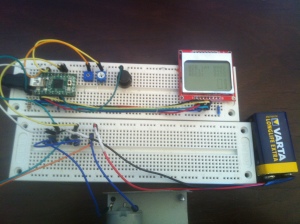I’ve adapted some basic algorithms used in my Pong/Breakout game on the Teensy 2.0 MCU to control (what will eventually be) an RC car. It currently has two ADC input channels and a serial connection which can be used to control the duty cycle of two PWM outputs. These PWM outputs then are input into individual BJTs (base pin) which is connected to an external 9V battery for motor power supply (the 3.3V Teensy power supply doesn’t cut it). Below is a picture of the user display and breadboard mess.
The box in the far bottom right rises/lowers with the speed while the box to the left “turns” to indicate which direction the RC car will face. The hope is to transmit data via an FM signal that indicates the speed and turning angle on a controller, while the serial connection will be used to send commands that stimulate a specific pre-programmed path that the RC car will follow.


